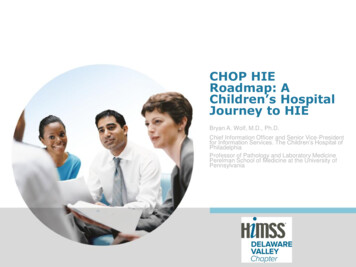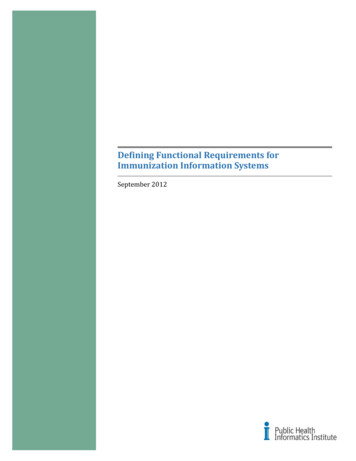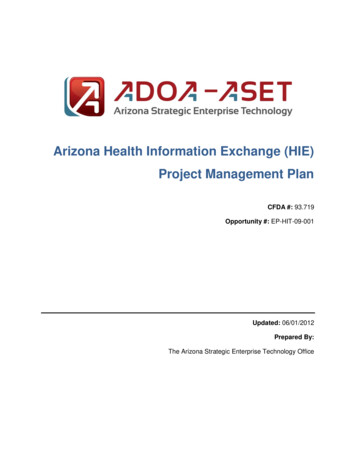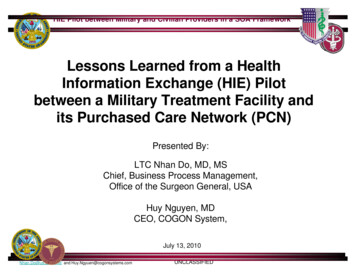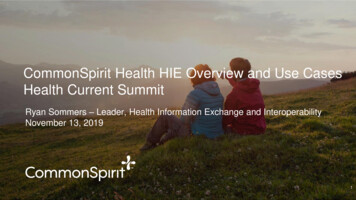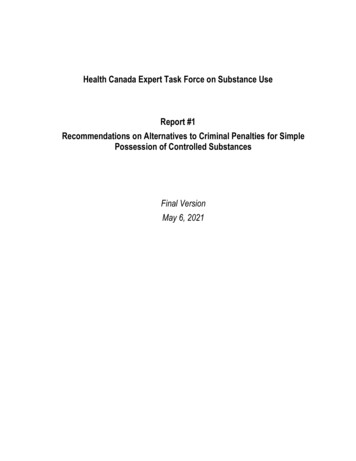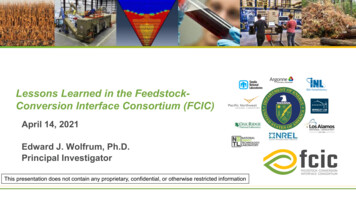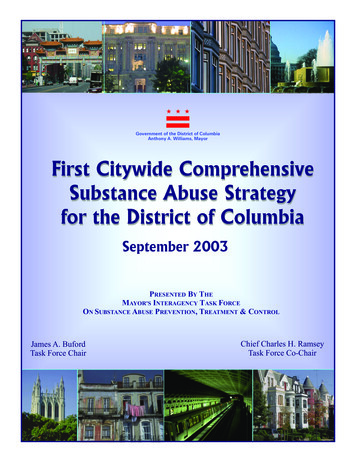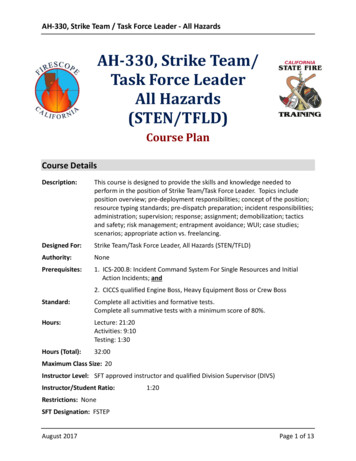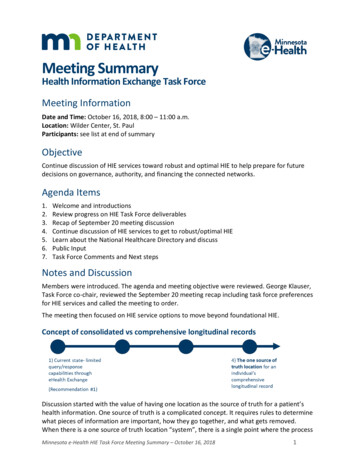
Transcription
Meeting SummaryHealth Information Exchange Task ForceMeeting InformationDate and Time: October 16, 2018, 8:00 – 11:00 a.m.Location: Wilder Center, St. PaulParticipants: see list at end of summaryObjectiveContinue discussion of HIE services toward robust and optimal HIE to help prepare for futuredecisions on governance, authority, and financing the connected networks.Agenda Items1.2.3.4.5.6.7.Welcome and introductionsReview progress on HIE Task Force deliverablesRecap of September 20 meeting discussionContinue discussion of HIE services to get to robust/optimal HIELearn about the National Healthcare Directory and discussPublic InputTask Force Comments and Next stepsNotes and DiscussionMembers were introduced. The agenda and meeting objective were reviewed. George Klauser,Task Force co-chair, reviewed the September 20 meeting recap including task force preferencesfor HIE services and called the meeting to order.The meeting then focused on HIE service options to move beyond foundational HIE.Concept of consolidated vs comprehensive longitudinal recordsDiscussion started with the value of having one location as the source of truth for a patient’shealth information. One source of truth is a complicated concept. It requires rules to determinewhat pieces of information are important, how they go together, and what gets removed.When there is a one source of truth location “system”, there is a single point where the processMinnesota e-Health HIE Task Force Meeting Summary – October 16, 20181
gets managed. Then the burden is not on every organization to manage the data, a situationwhich can increase inconsistencies and errors.A member pointed out that Epic organizations are moving to consolidated/comprehensiverecords, so a separate comprehensive record would be duplication. Today, clinicians aredistrustful about what information they pull in from other organizations. Epic-usingorganizations query for information and the multiple documents received are indexed soproviders can look at what information they want and pull just that into the EHR. Acomprehensive record might be too much information for the clinician to manage. Anothermember countered that without the comprehensive record, is there so much work to gettingthe information that HIE isn’t used at all, or is it used much less?An assumption was made that the comprehensive record is dynamic, not static, so it iscontinually updated. If the patient owns the record, and not the organization, there is value interms of transparency, etc. It is aspirational, but aligned with national patient-centered goals.Discrete vs. non-discrete data was also discussed. A comprehensive record would (eventually)have discrete data, so that data could be integrated and used. It was noted that states thathave a single with one HIE (organization) house such a comprehensive records for individuals.They use or convert information into discrete data to increase the ability to use the informationmore effectively and efficiently. Source information may generate from multiple places, sinceeach patient-provider visit is documented and updated at the time of the visit in thatorganization’s EHR. The comprehensive record is able to combine information from multiplevisits with multiple providers in multiple provider organizations across the continuum of care. Adetermination needs to be made as to where each individuals’ comprehensive record wouldreside – possibly assigned to one of the nodes on the network.It was noted that from both clinical and patient standpoints a consolidated record within asingle organization’s EHR does not provide all of the information needed.One question raised was, if there is not a comprehensive record, could (non-Epic users) stillquery (possibly through a central locator), see a table of contents from all nodes, and stillchoose to get what we want?Another question brought up is that there is still a need to store the comprehensive recordsomewhere, so even the Epic users can choose to render what they want into their own EHR.‘There are certain things I need to know about a patient, but I don’t need everything.’There was a comment that if the comprehensive record existed somewhere as the source oftruth, you can manage data quality better. Many agreed that data quality is an issue withsharing and using HIE.This is more than storing the comprehensive record locally and retrieving on demand, as thereare other touchpoints for this data. The comprehensive record would potentially providepatients with a more complete health record. Sometimes we do not get much information fromanother provider in a current referral. The comprehensive record would give us completeinformation, and the patient would know we have it, or confirm the information. ”I think thefundamental question is do I, as a clinician, want all of that information or does the patientwant all of that information in one place? Should the patient have one source of truth?”A comment was that one should not confuse what you see on the screen in an EHR with whereit comes from. The data may be coming from many locations and it is really just about how it isMinnesota e-Health HIE Task Force Meeting Summary – October 16, 20182
presented to you. Determining what you see is not technically relevant to where it is stored.The data quality from having it in one place is most important here.Preferential Vote: Support for establishing goal for one source of truth location for anindividual’s comprehensive longitudinal record.Fist (No)01 (No, unless specific changes)32 (I’d rather not but can live with it)13 (OK, I can support the option)24 (I support the option)45 (I strongly support the option)0Patient directory discussionThere was discussion about three ways to use HIE: 1.) ‘push’ information to a specific location,2.) ‘pull’ (query/response) information from a number of locations, and 3.) ‘event alerting’(hospital or emergency room admittance or hospital discharge notice to a specific identifiedhealthcare provider for a specific person when needed). We may be looking at multiplesolutions to get to all three. There are also multiple transport methods that may be used (e.g.,Direct, FHIR, API) – which will be considered during implementation discussions.Option 2 reactions: For providers who are not HIO participants, option 2 is not supported;option needs to be broader than HIOs. The HIOs have suggested this option as a ‘quick’ win toget event alerts moving statewide in addition to CCD exchange through the eHealth Exchange.It could show results sooner while still moving toward the end goal.Option 3 reactions: Would a central record locator service duplicate the eHealth Exchange?There is value from the effectiveness and efficiency in how HIE shared services are set up. Forexample, some organizations may query and receive nothing back; need to ensure the designworks. The eHealth Exchange currently offers only CCD exchange. This query option couldsupport more transactions. Providers not using the eHealth Exchange need this information too.Option 4 reactions: Many agreed with the need for a directory, but there were concerns abouthaving to tie it, at this point, to the goal of a comprehensive longitudinal record. Task forcemembers asked about the directory’s purpose – would it scrub for patient identifiers and returnresults to node participants, etc.? Using this as a centralized EMPI would be helpful forimproving patient matching. It was also encouraged to incorporate an EMPI with the Medicaidpopulation, with potential federal match dollars (75%) for future sustainability.After discussion of options 2, 3, and 4, the group decided to make two changes.Minnesota e-Health HIE Task Force Meeting Summary – October 16, 20183
1) For option 3, the central record locator service would include a central consentmanagement so that event alerting could also be part of the design capabilities. It wasnoted that consents are obtained and managed at provider organizations. However, thecurrent consent for HIE is received by and currently managed at each of the HIOs, so it isknown whether information can be shared or not. Since Option 2 is set up through theHIOs, it already has the HIE consent identified for sharing event alerts.2) For option 4, remove in the design section ‘to use to query for comprehensive longitudinalrecords, and’ so this option can be used without reference to the comprehensive record.Preferential Vote: Three separate votes indicating support for options 2, 3, and 4Fist (No)1 (No, unless specific changes)2 (I’d rather not but can live with it)3 (OK, I can support the option)4 (I support the option)5 (I strongly support the option)Option 2330130Option 3021340Option 4000190The group attempted to vote for a favorite option, however noted it is difficult as these are notmutually exclusive options.National Healthcare Directory (provider directory)As requested at the last meeting, MDH staff followed up on the National Healthcare Directory(provider directory) and the potential for pilots. The Office of the National Coordinator (ONC)reported a number of reasons why pilots are not being offered. However, after two years ofwork with many stakeholders, the standards and implementation guide for the healthcaredirectory was validated by the HL7 group. This is available for states to use when setting up acentral provider directoryIn discussing the value of a provider directory, comments included: there is no good source for all provider information;record cleanup is a nightmare and no organization has solved it;most organizations have difficulty getting addresses, even Direct,it is a challenge to maintain addresses;could help with many things, including attributed information (FHIR capabilities).However, it was also noted that it will take a lot of work to get a central provider directory toreconcile with our directories at the participating organizations.Use cases: What would drive this? The highest priorities.Use cases from the ONC healthcare directory information were shared and membershighlighted which use cases they saw as a high value. The first use case identified was referralsand transitions of care, especially in the context of provider and patient; using a providerdirectory for transitions of care is a great opportunity to optimize workflows.Endpoint discovery (e.g., EHR endpoint, direct address, quality reporting, credentialing wereconsidered priorities by number of task force members.Minnesota e-Health HIE Task Force Meeting Summary – October 16, 20184
One member mentioned that WISHIN (Wisconsin Statewide Health Information Network) has afront-facing provider directory for consumers that has been well received.From a health plan perspective, all the use cases seemed important. Most agreed that toprioritize the use cases, it’s a matter of your organizations’ worst pain points.Preferential Vote: support a provider (healthcare) directory as a shared HIE serviceFist (No)1 (No, unless specific changes)2 (I’d rather not but can live with it)3 (OK, I can support the option)4 (I support the option)5 (I strongly support the option)000019Public InputNo public was given during the meeting.Participants:Timothy R. Getsay, Gillette Children’s Specialty Healthcare (not in attendance)George Klauser, Lutheran Social Service of Minnesota, HIE Task Force Co-ChairMike Lilly, Ridgeview Medical CenterJonathon Moon, UCareSteve Odd, Allina HealthChad Peterson, The Koble GroupPaula Schreurs, Sanford HealthPeter Schuna, Pathway Health, HIE Task Force Co-Chair (not in attendance)Jackie Sias, Minnesota Department of Human ServicesJeffrey Stites, Context LawEleanor O. Vita, Mayo ClinicDeepti Pandita, Hennepin County Medical CenterMDH Staff: Jennifer Fritz, Melinda Hanson, Dave Haugen, and Anne SchloegelMMB Staff: Matt Kane (Management Analysis and Development)Next HIE Task Force meetingTuesday, November 20, 2018, 9:00 a.m. – 12:00 p.m., Wilder CenterMinnesota Department of Health85 East 7th Place, Suite 220PO Box 64882St. Paul, MN alth.state.mn.us11/5/2018To obtain this information in a different format, call: 651-201-5979. Printed on recycled paper.Minnesota e-Health HIE Task Force Meeting Summary – October 16, 20185
Minnesota e-Health HIE Task Force Meeting Summary - October 16, 2018 1 . Meeting Summary . Health Information Exchange Task Force . Meeting Information . Date and Time: October 16, 2018, 8:00 - 11:00 a.m. Location: Wilder Center, St. Paul . Participants: see list at end of summary . Objective
